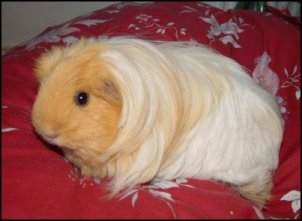Keeping Cool.
This is a page of ideas for keeping your pets cool during the hot weather. Please click here to send me your ideas. Many of these ideas are not mine and came from contributors on the Chinchillas Unlimited discussion boards (which sadly seem now to be down), but I felt that it would be useful to list them here. Although we've had a couple of pretty dreadful summers in the last two years before that we had some real heatwaves in the UK with temperatures getting up into the 30s. Chinchillas are stuck with a big fur coat and can get heat stroke very quickly at temperatures above about 24 degrees centigrade (75F), once it gets to 30 they are in real trouble. Although less of a problem, other pets can also suffer from the heat particularly Rabbits and Guinea Pigs outside or in a shed in a hutch or in the sun in their run.
Emergency Treatment
This information was given to me by an experienced chinchilla breeder but would also apply for other animals such as rabbits or guinea pigs.
If you have a sick animal of any kind it is vital to call the vets immediately, but in the case of heatstroke quick action may also be vital.
If you have an overheated pet watch them carefully. Signs of overheating are bright red hot ears and lethargy - chinchillas are often quite lethargic during the day but a sick chinchilla will show no interest in their favourite treat. In severe cases the chinchilla may collapse and become unresponsive.
For severe overheating put them in their travel cage or box and place them in an OPEN fridge or freezer for a few minutes. If you don't have access to a fridge or freezer then get someone to go to the supermarket and get lots of packets of frozen vedge to pack around their travel cage.
In a real emergency you can plunge a chinchilla to the neck in tepid (not cold) water to bring down their temperature down rapidly. Preferably this would be done under telephone instruction from a vet. Wrap them in a towel afterwards and put in a cool quiet place.
Try to get the chinchilla to take fluids (powders to make a rehydration solution such as Diarolyte can be purchased from chemists) but don't force them.
If they were collapsed you need to get them to the vets. Beware transporting them in a very hot car - drive it round with the windows open or the air con on to cool it down and pack around the travelling cage with frozen stuff. Vets will see an animal out of hours in an emergency, but will normally need you to meet them at the surgery - you can usually also get advice by phone.
Ideas for Keeping Cool
Air Conditioners
Air conditioning units can be bought in large DIY stores such as B&Q at surprisingly reasonable prices -they are bulky (see photo above) and a bit noisy but are mobile so you can cool down your bedroom when the chinchillas are finished with it. Consider buying one when they are on special offer in the cooler weather. Expect to pay at least £200-300 for one - the cheaper ones are often just air coolers which don't actually refrigerate the air. They will have a BTU cooling capacity value on them which indicates how much they cool the air by. I have found a good page about air conditioners here or try a search on "buying an air conditioner" on a good search engine like Google. Unfortunately it can be difficult to get units once a heatwave has started and so if you own chinchillas it is worth considering buying one in advance.
It's worth noting that if you bring an air conditioner into a very hot room it will really struggle to bring the temperature down - the best bet is to start it up in the morning before it gets really hot and keep it on.
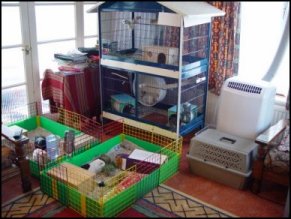
August 5th 2003 - we had to get out the winter hutches and bring the piggies in to an air conditioned room.
If you are relying on air conditioners check them regularly. It is possible for the exhaust host to fall back into the room and this will heat it up very quickly. Also power cuts will not only turn off the aircon but may mess up any timers you have. They need the water draining from them regularly or they may cut out and it is possible to get blown fuses. Read the operating instructions, clean the filters and get them serviced once the weather gets cool.
If you work and cannot leave the window open for the hose one approach is to cool the room down as much as possible in the morning and then return at lunchtime to cool it down again.
If you have plenty of money and want to feel really secure in your furrys' comfort then through wall systems can be fitted, if you go for one of these make sure that it resets if there is a power cut for added peace of mind.
Monitoring
A thermometer in the chinchilla room is very important as you can become accustomed to the heat and not realise that it is getting too hot for the small and furries.
I have investigated getting a wireless thermometer to allow remote monitoring of the chinchilla room over the Internet but sadly these are not available. However you can get quite reasonably priced wireless cameras that you can monitor over the Internet - next summer I'm planning to set up one of these facing the room thermometer so I can check on the temperature from work. The guys in the Maplins store near to where I work were very helpful about what they had available.
Warning on Fans
A fan on human skin cools you down because people sweat and heat is lost when the sweat evaporates - a fan will help blow away the evaporating sweat so that we cool down more. Chinchillas don't sweat so unless it is bringing in cooler air it won't help at all. They can be useful to blow cooler air from outside into a room but iIf the air outside is as hot as inside fans will only circulate the warm air around and will not cool your pets down.
Cooling the Room
Keep cages out of sunlight and move them to the coolest room in the house where possible and close curtains on windows where sun is shining in. If curtains are thin try to find something to hang over the curtain rail to increase the shade. You can get blackout blinds that reflect the sun, or in an emergency buy some Cool Glass from the garden centre and paint it on the outside of the window. This is white stuff that you paint on greenhouses for the summer that can be cleaned off easily.
Remember that electrical equipment, particularly fridges/freezers and computer running in the room will heat it up so turn everything off.
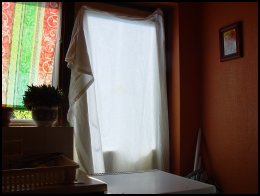
A sheet pinned up over a window with no blind - not pretty but it works.
Open windows and doors when you are in, place a fan by the window to circulate the cooler air. Try to get a through draft through the house or room by opening multiple windows front and back and using fans to move the air.
Even if you haven't got room for the whole cage they can be put in a carry cage with food and water and put in a cool cupboard. Make sure that there is plenty of air and that it won't heat up during the day. A carry cage is also easier to cool down with frozen towels and ice blocks than a whole cage. This can be useful for bringing guinea-pigs indoors from their hutch and they generally don't mind spending a hot day in a small space if they have plenty of hay to browse on
On a really hot day it can actually be cooler inside than out so in this case it may be better to shut the windows to keep the cool air in.
Lots of Water
Make sure that they have plenty of clean, cool water. Clean bottles regularly and keep them out of sun to prevent green algae forming. Algae can be cleaned from bottles by putting a handful of rice in with a small amount of water and shaking vigorously. Make sure you remove all of the rice before refilling it. But honestly it's sometimes better to just replace the bottle. In really hot weather I put some ice in the water bottles and fix a freezer pack behind them to keep them cool as
long as possible.
Cold Items in Cage
Put the dust bath in the freezer for a while. This doesn't freeze the dust but made it nice and cool for a while. Gnaw blocks can also be cooled down.
Terracotta floor tiles can be put in the freezer and then in the cage as can terracotta flower pots, and the dishes for them can be large enough to lie on. Make sure there is no sticky ice on them before they are put in. This is one of the best ideas for guinea pigs and rabbits stuck in hutches outside.
Smaller terracotta flower pots or jars, that are small enough for the fridge or freezer are ideal as your chinchilla can get right inside. Hanging urns (see picture below) or planters often have flat backs and make nice cool caves, but watch out for any rubber bungs or holes that little noses can get stuck in. The ceramic sandbaths shown below, which again would fit in the freezer, seem to only be sold in the US, but have a look around for clay/ceramic cookware that would do a similar job. With anything like this keep an eye out for chewing damage as it might not be good for a chinchilla to swallow bits that it chewed off.
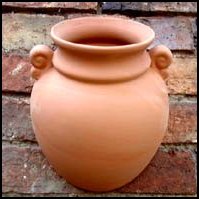
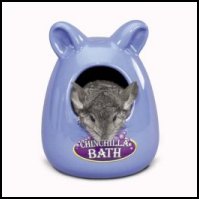
Freeze cheap tins of beans, spaghetti or soup and rinse off the sticky ice on outside of tins before putting in cages. Try to secure them so they don't roll about. Freezer packs or frozen bottles of water can be put inside tin cans and placed in the cage. For guinea pigs and less chewy rabbits wrap a frozen bottle of water in a towel to protect them from the ice.
I have heard that chinchillas like an ice cube to lick (melt it in your hand first to stop it being sticky). These can also be made with diluted (unsweetened) fruit juice or with a raisin/dried fruit inside. Other suggestions include freezing small cubes of apple or banana on a willow stick.
As a last resort wet towels in cold water, ring out well and drape over cages. Use old towels as they will get chewed although putting newspaper underneath may help with this. Putting a fan on them will make the water evaporate more quickly and cool the cage further. If you have a freezer you could wring out a wet towel and freeze it.
Metal trays cages can literally be stood on a number of ice packs to reduce the temperature.
Keep Exercise and Stress to a Minimum
Don't handle animals a lot and only allow them out to play if the room is cool enough (and shut windows and doors first to avoid escapes) - it is better to have a bored chinchilla than an overheated one. If your wheel turns up during hot weather then hang onto it until it is cooler but there's no real need to take existing wheels out.
Don't transport animals unless absolutely necessary - hot cars are a killer and it goes without saying that they should never be left in the car when you are not there.
Note on Guinea Pigs and Rabbits
Guinea Pigs and Rabbit hutches should not be stood in the sun. Every year people loose their pets though heat stroke.
They will appreciate going out in their run as the grass will stay cool during the day. Make sure that you stand the run in the shade or at the very least make sure that you shade part of the run.You can buy garden umbrellas surprisingly cheaply from DIY stores. I also use an old, light coloured, curtain or sheet to cover the top of the guinea pig's run. They don't really like going in the sun and it has the added benefit of stopping birds or cats sitting on top and scaring them.
Tempting though it may be on hot days never leave them in the run overnight - foxes can easily dig under the run and kill them. In warm weather when they have cubs they can also come down during the day in some areas.
Guinea pigs and rabbits with pink ears should have a children's non-toxic sun block put on their ears if they can get into the sun as they can be easily burnt.
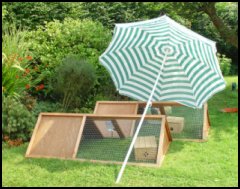
Long haired Rabbits and Guinea Pigs benefit from a haircut. They won't necessarily look as pretty with short hair but they will be much more comfortable. Cut a small amount of hair off at a time to make the cut less blocky. Angel my Sheltie guinea pig is very good about being trimmed and it has the added benefit that she doesn't need combing every day.
Angel before and during a haircut. And I really need to get my roots done!
Keep cages spotlessly clean - this is particularly important for rabbits as they can get Fly-Strike if their bottoms get dirty. This is a very distressing and often fatal condition. I have seen an anti-fly-strike product at my vets which is probably worth investigating if you have rabbits but they are no substitute for good hygeine.
And finally try not to use plastic houses for your pets as these can turn really hot and sweaty.
Pets in Tanks.
For small furries in a tank you can pack cool stuff around one corner - cheap frozen vedge is good for this as you can shape the packs to fit. Jirds and Gerbils are much less bothered by the heat but will still appreciate a nice cool corner to sit in. Under no circumstances leave their tank in the sun as it will act like a greenhouse. Somebody told me about this site called Chilling the Hammy about an owners attempts to keep their hamster cool - very entertaining.

Using frozen tiles to cool down the Jirds.






